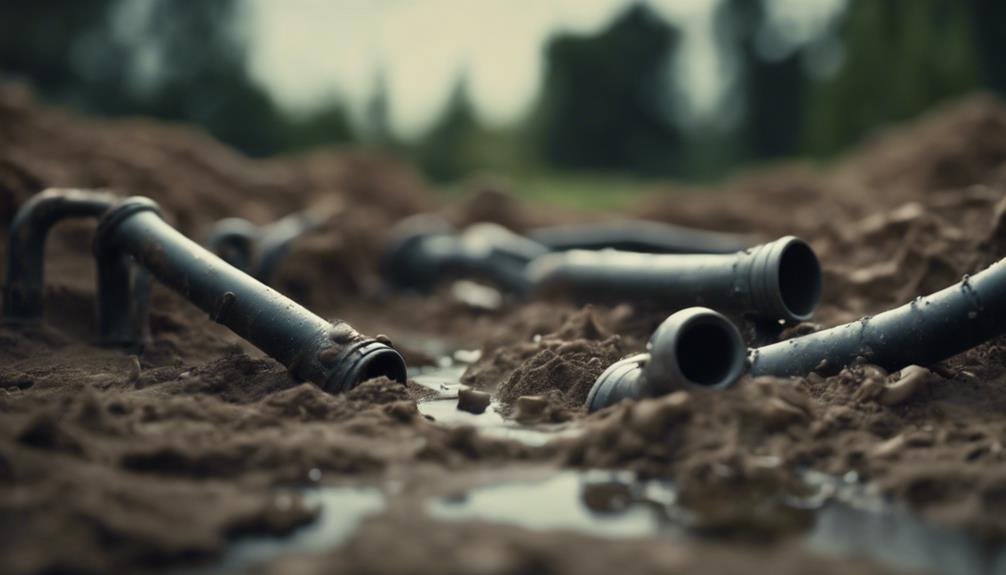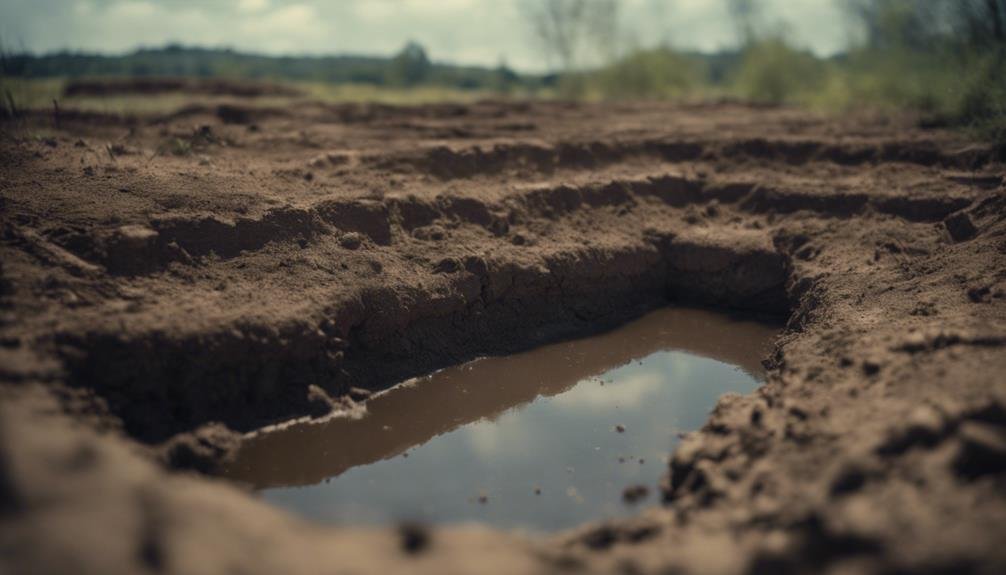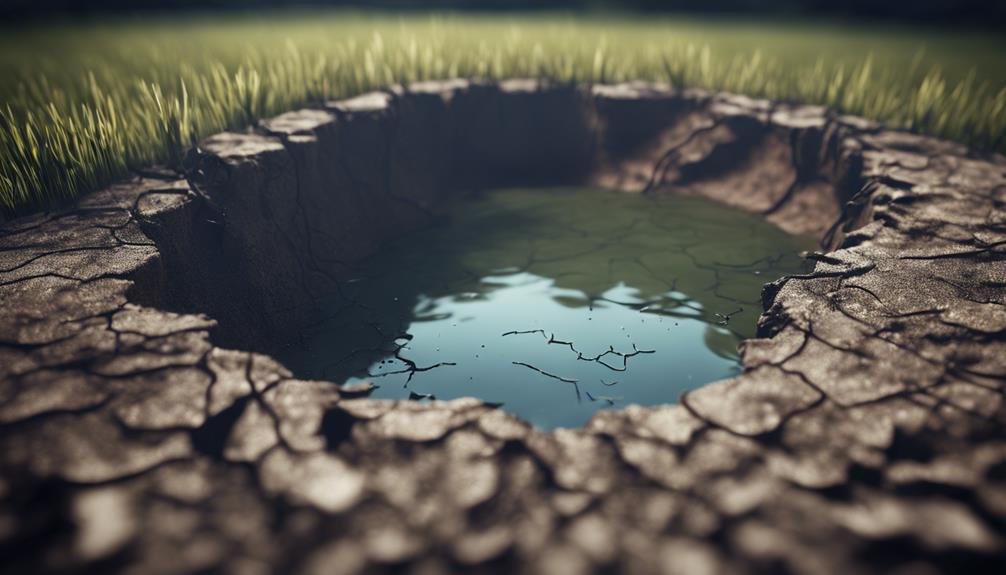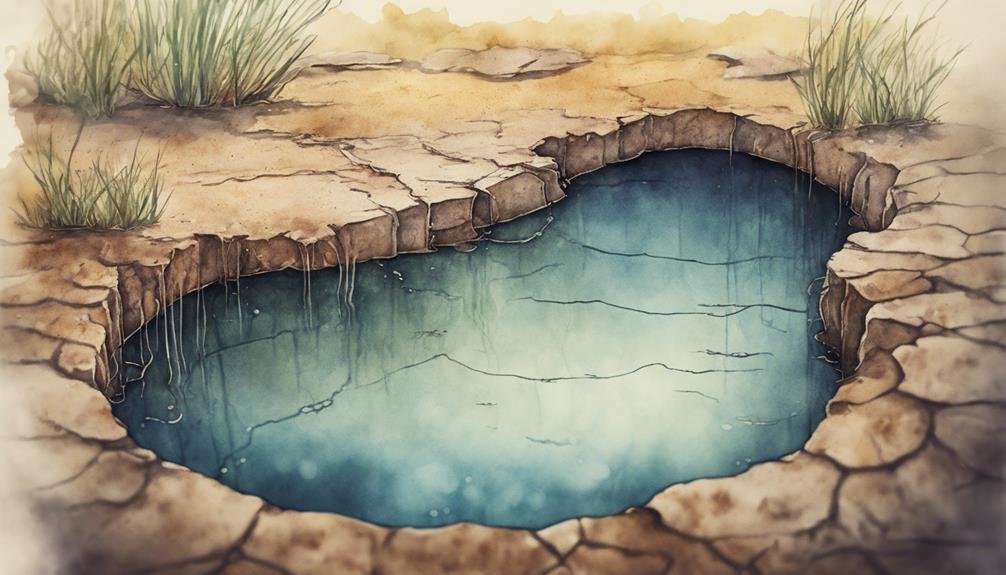We have identified several common factors that can lead to leaks in ponds.
Some of the links in this article may be affiliate links. If you make a purchase through these links, we may earn a small commission at no extra cost to you. Thank you.
Cracks in liners caused by extreme temperatures or sharp objects are frequent culprits, along with improper installation such as inadequate seam sealing or drain fittings. Over time, liners can also be damaged by burrowing animals and shifting ground.
Additionally, overflowing skimmers, structural issues in concrete ponds, and cracked filter components can contribute to leaks. It is crucial to monitor water levels regularly to detect leaks early on.
Understanding these causes is essential for effectively pinpointing and resolving pesky pond leaks.
Liner Cracks
Pond leaks often stem from liner cracks, which can develop due to environmental factors or physical damage. These cracks allow water to slowly seep out, leading to a gradual drainage of the pond.
Factors such as extreme temperatures, UV rays, rough surfaces, or sharp objects can contribute to liner breaches. To prevent leaks, it's crucial to prepare the pond area by clearing debris and rocks that could damage the liner. Choosing a high-quality liner designed for outdoor use and proper installation can reduce the risk of cracks or punctures.
Regular inspections and immediate repairs can help identify and fix small leaks before they escalate, ensuring the pond remains watertight and functional over time.
Faulty Seams
Improperly installed liners can lead to pond leakage, with faulty seams being a key culprit. Seams are where liner panels meet and are sealed together. When these seams aren't done correctly, it can result in leaks. This can happen due to various reasons, such as not having enough overlap between liner panels, using the wrong sealing technique, or using sealants that aren't compatible with the liner material.
To prevent issues with seams, it's crucial to follow the manufacturer's installation instructions diligently. This involves ensuring that liner panels overlap adequately, using the appropriate sealing method and sealants that work well with the liner material, and making sure that the seams are tightly sealed along their entire length.
Regularly inspecting and maintaining the seams can help detect and fix any problems before they escalate into significant leaks.
Plumbing Issues

Let's look at two common plumbing issues that can cause leaks in ponds: pipe cracks/breaks and faulty drain fittings. Over time, pipes that bring water into or out of the pond may develop cracks or breaks, leading to water leakage.
Similarly, if drain fittings aren't installed correctly or start to deteriorate, they can develop gaps that allow water to escape through unintended openings.
When pipes develop cracks or breaks, water can seep out, causing a drop in water levels in the pond. This not only affects the aesthetics of the pond but can also disrupt the ecosystem within it.
Faulty drain fittings, on the other hand, can create leaks that may go unnoticed until significant water loss occurs. Regular inspections and maintenance can help prevent these issues and ensure the proper functioning of your pond.
To address pipe cracks or breaks, consider using durable PVC pipes or flexible rubber hoses that are less prone to damage. For faulty drain fittings, investing in high-quality fittings and ensuring proper installation can help prevent leaks.
Pipe Cracks/Breaks
Damaged pipes are a common cause of leaks in ponds, leading to water loss and soil seepage. The presence of cracks or breaks in pipes can result from factors like ground movement, intrusion of tree roots, or general wear and tear. Identifying these pipe issues is crucial in addressing declining water levels in ponds.
To detect pipe-related problems, a thorough examination of the plumbing system is necessary to spot any visible signs of damage or leaks. Conducting pressure tests can also help pinpoint weak areas or hidden cracks within the pipes.
Once the damaged sections are identified, prompt repair or replacement is vital to prevent further leakage and restore the pond's integrity.
Using high-quality materials and proper installation methods is essential to prevent future pipe failures. Regular maintenance checks play a key role in early detection of potential issues before they escalate into significant leaks.
Timely addressing of pipe cracks or breaks ensures the longevity of the pond and minimizes unnecessary water loss.
Faulty Drain Fittings
Faulty drain fittings can be a common source of water seepage and leakage in ponds. Over time, these fittings can become loose or deteriorate, leading to water escaping from the pond. Even small cracks or gaps in the fittings can cause slow leaks that drain the pond.
Regular inspection of drain fittings is crucial to identify any damage or deterioration, such as cracks, loose connections, or corrosion. If issues are found, it's important to tighten, seal, or replace the fittings to prevent further leakage. Proper maintenance of these components is essential to ensure the pond remains watertight and to avoid unnecessary water loss.
Consider upgrading to more durable and corrosion-resistant drain fittings to minimize future leaks and prolong the lifespan of the pond's plumbing system. By taking proactive measures, you can prevent issues and save time and resources in the long run. Investing in high-quality fittings can provide added peace of mind and help maintain the integrity of your pond's water system.
Overflowing Skimmers
One common reason for pond leaks that often goes unnoticed is when skimmers overflow, causing water to drain out of the system. This issue can be prevented by implementing some simple measures to maintain the water level in your pond. Skimmers overflow due to various reasons such as debris blockage in the skimmer basket, pump system malfunction, excessive rainfall, or lack of proper maintenance.
To avoid overflowing skimmers, it's crucial to regularly clean the skimmer basket and ensure the pump is functioning correctly. For larger ponds or those prone to heavy rainfall, consider installing overflow pipes or upgrading to a larger skimmer size. Conducting routine inspections and maintenance can help identify and address potential problems before they worsen.
Burrowing Creatures

Let's explore how burrowing animals such as muskrats and crayfish can damage pond liners.
Muskrats create intricate tunnel networks that can cause water to seep out, leading to pond drainage issues. Similarly, crayfish burrows can weaken the liner, potentially causing leaks.
It's crucial to detect and repair these burrows promptly to ensure your pond remains water-resistant. By addressing these burrowing activities early on, you can maintain the integrity of your pond liner and prevent water loss.
Muskrat Tunnels
Muskrats, rodents native to North America known for their semi-aquatic nature, have a tendency to create intricate tunnel systems that can compromise the integrity of pond banks and liners, leading to potential leaks. It's crucial to stay vigilant and take proactive steps to address this issue.
Imagine a once-beautiful pond now marred by unsightly piles of dirt and debris scattered along its edges, a clear sign of muskrat activity. As water levels gradually decrease due to seepage through the tunnels, the aquatic life within the pond struggles to adapt to the changing habitat. Your investment in maintaining a tranquil oasis is at risk of slowly dwindling away.
Muskrats excel at constructing elaborate entrances to their burrows beneath the water's surface, establishing a network of tunnels that pose a threat to the structural stability of ponds. Their burrowing can compromise pond liners, resulting in water leakage.
To combat this, it's essential to employ effective deterrents and monitoring mechanisms to detect and address muskrat tunneling promptly. By understanding their behavior and taking preventive action, we can protect our ponds from the damaging consequences of these industrious rodents.
Crayfish Burrows
Crayfish are known to tunnel into pond banks, posing a serious threat to water retention. These small crustaceans dig into the soil, creating intricate networks of tunnels that can weaken the structure of the pond. In some instances, crayfish burrows have caused significant leaks, resulting in water loss and potential damage to the surrounding area.
Crayfish tend to burrow close to the water's edge, where the soil is damp and nutrient-rich. Their tunnels can reach several feet deep and branch out in various directions. Over time, these tunnels can expand and age, providing pathways for water to seep through, causing gradual leaks or even complete pond failure.
Identifying crayfish burrows involves looking for small, circular openings near the water line, often accompanied by piles of excavated soil. While these burrows may be hard to spot initially, they can become more visible as they grow, increasing the risk of structural damage.
It's crucial to address crayfish burrows promptly to prevent further harm and maintain the integrity of the pond.
Shifting Ground
Keeping an eye out for shifting ground is crucial for maintaining the integrity of our pond. When the soil moves and disrupts the liner, it can result in leaks, leading to costly repairs and water loss. Here are four potential issues that can arise if we neglect this problem:
- Small cracks in the liner may go unnoticed, causing water to slowly seep out.
- If the liner shifts completely, it can result in sudden and significant drainage.
- Surrounding structures like retaining walls or decking may suffer damage.
- Aquatic life could be endangered due to unsafe conditions in the pond.
Shifting ground can be caused by factors such as soil erosion, improper installation compaction, or changes in the water table. Regular inspections are necessary to spot signs like soil slumping, exposed liner, or water seepage.
Detecting these issues early on and addressing them promptly can prevent further damage and expensive repairs. By staying proactive and understanding the risks involved, we can ensure our ponds remain stable, secure, and free of leaks.
Structural Defects

When constructing a pond, it's crucial to ensure the materials used are of high quality and that the installation is done correctly to prevent structural defects. These defects can lead to leaks in the pond lining, causing water loss and potential damage to the surrounding area. It's essential to inspect the pond regularly for cracks, holes, or weak points that could allow water to escape.
Concrete ponds are prone to cracks if the concrete wasn't mixed, cured, or reinforced properly. Flexible liners can develop holes or tears if they weren't installed correctly or if sharp objects punctured them. Rigid liners like fiberglass or plastic may crack or separate from the pond walls if the underlying surface shifts or settles unevenly.
To avoid structural defects, it's vital to use appropriate materials specifically designed for pond construction and follow the manufacturer's installation guidelines accurately. Additionally, preparing the site correctly with a stable and level base is crucial.
Regular inspections can help in early detection of issues before they escalate, saving on costly repairs and water losses in the future. By addressing structural defects promptly, we can maintain the integrity of the pond and preserve its functionality for a longer period.
Filter Leakage
Apart from ensuring the filter's structural integrity, it's crucial to assess the potential for leaks in the filtration system. Over time, the filter components may develop cracks or holes, allowing water to seep out. Furthermore, the connections between the filter and the pond can degrade, resulting in possible leakage. Here are four common reasons for filter leaks to consider:
- Material breakdown due to exposure to sunlight, chemicals, or extreme temperatures.
- Improper installation or lack of maintenance leading to loose fittings and seals.
- Physical damage from impacts or interference by animals.
- Clogs causing pressure buildup and potential ruptures.
To detect filter leaks, visually inspect the system for any signs of moisture or dripping. Conducting pressure tests or dye tests may also be necessary to identify the exact location of the leak.
Timely addressing of filter leaks is crucial to prevent water loss and protect the pond from structural damage. By understanding the main causes, proactive steps can be taken to maintain the filtration system and prevent leaks from occurring.
Water Loss

Keeping an eye on water levels is crucial for spotting leaks in ponds. A noticeable decrease in water levels could indicate a leak, but we should consider factors like evaporation and water usage as well. If there's a significant and unexplained drop in water levels, it's likely there's a leak present.
To pinpoint the issue, measuring the rate of water loss is key. One way to do this is by marking the water level and checking it again 24-48 hours later without adding any water. If there's minimal change, it's probably due to evaporation. However, a more significant drop suggests a leak, and the rate of loss gives us an idea of its size.
It's also important to pay attention to when the water loss occurs. A steady decline could be related to the ground's porosity, while a sudden drop overnight might point to cracks in the pond liner. Weather conditions, such as heavy rains, can temporarily mask leaks too. By tracking these changes over time, we can uncover patterns that reveal the root cause.
Identifying the underlying issue is crucial for determining the best repair approach. Different solutions are needed for groundwater seepage compared to physical liner damage. Through consistent monitoring and deduction, we can effectively seal up our ponds and prevent further water loss.
Conclusion
Preventing pond leaks demands consistent attention. While common issues like liner malfunctions and filter breakdowns are known culprits, the underlying cause may remain hidden.
Regularly inspecting all pond components helps identify and address problems early on, ensuring the preservation of these serene water features.
By staying vigilant and knowledgeable, we can effectively tackle leaks and maintain these peaceful oases for everyone to appreciate.

